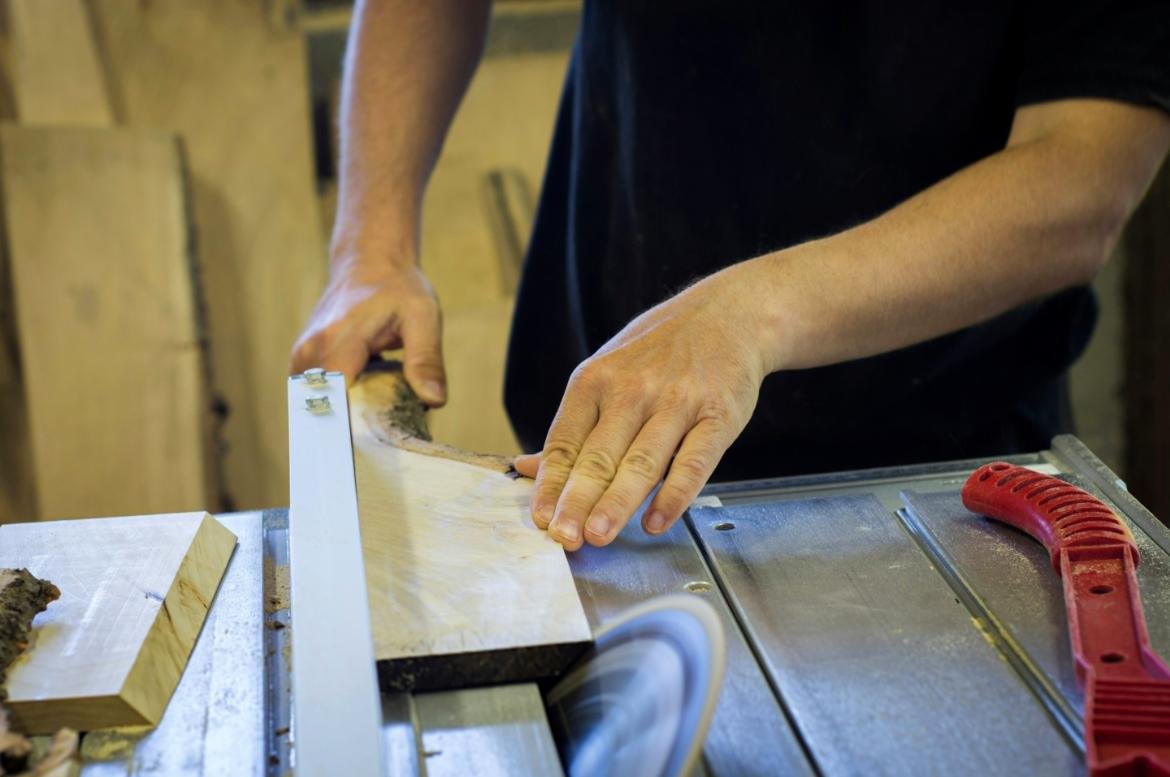A table saw is an indispensable tool for both beginner and experienced woodworkers, providing precision and versatility for a range of cutting tasks. Its primary function is to make straight and clean cuts in large sheets of wood, offering various features that enhance its usability. There are three main types of table saws available in the market: portable, contractor, and cabinet saws, each catering to different needs and preferences.
Portable table saws, as the name suggests, are designed for mobility and convenience. They are lightweight and compact, ideal for those who need to transport their saw to different job sites. While they may not offer the same power or cutting capacity as larger models, portable saws are perfect for small projects or home workshops where space is limited. The primary advantage is their affordability and ease of use, making them suitable for beginners.
Contractor table saws, on the other hand, strike a balance between performance and portability. They are more robust than portable models, featuring a larger cutting surface and a powerful motor. This type of saw is typically used in professional settings but is also accessible for ambitious beginners looking for greater precision and durability. While they can be heavier and less mobile than their portable counterparts, they often come with added features like better fence systems and dust collection options.
Finally, cabinet saws are the most substantial and feature-rich option on the market. These saws are built for serious woodworkers who demand accuracy and extensive use. They come equipped with advanced features, including heavy-duty construction, superior safety mechanisms, and excellent dust management systems. While cabinet saws may represent a significant investment, their enhanced performance and capabilities make them a worthwhile choice for a dedicated workshop.
Understanding these varying types of table saws will facilitate informed decision-making when purchasing this crucial woodworking tool, equipping beginners with the knowledge to align their choice with their specific requirements and future projects.
Safety Features to Consider
When embarking on your woodworking journey, acquiring a table saw necessitates a thorough understanding of its safety features. Adequate safety measures are crucial, particularly for beginners who may not yet be familiar with the potential risks associated with using this powerful tool. Several key safety features deserve attention, including blade guards, anti-kickback pawls, and riving knives.
Blade guards are integral to maintaining a safe working environment. These protective devices cover the blade during operation and help prevent accidental contact. Many modern table saws come equipped with adjustable blade guards that can be repositioned based on the height and angle of the cut, ensuring safety without sacrificing functionality. It is essential to consider a table saw with a robust, easy-to-use blade guard to enhance your protection while cutting.
Anti-kickback pawls are another critical component to look for. These pawls grip the wood as it moves through the saw and prevent it from being thrown back toward the operator—commonly referred to as “kickback.” Ensuring that the saw you choose has quality anti-kickback mechanisms will facilitate a safer cutting experience, mitigating the risk of injury.
Additionally, riving knives play a significant role in enhancing safety. A riving knife is positioned just behind the blade and keeps the kerf open during cutting, which minimizes the chances of kickback. Unlike older table saws that may use separate splitter devices, a built-in riving knife remains attached during every cut, providing continuous protection as you saw through various materials.
Ultimately, prioritizing these safety features in your table saw selection is essential for creating a safe crafting space. A well-designed saw encompassing effective blade guards, anti-kickback pawls, and riving knives not only grants peace of mind but also supports an enjoyable woodworking experience. By being mindful of these features, beginners can confidently engage in their projects while minimizing potential hazards.
Power and Motor Considerations
When purchasing your first table saw, understanding the power and motor types is crucial for ensuring optimal performance. The power ratings of table saws typically range from 1.5 to 5 horsepower (HP). For beginners, a saw with 1.5 to 2 HP is generally sufficient for most woodworking projects, as it provides adequate power for cutting various materials like plywood and hardwood. The horsepower rating plays a significant role in the efficiency and quality of cuts, particularly when working with thicker or denser materials.
Next, it is important to understand the differences between direct-drive and belt-drive motors. Direct-drive motors are integrated directly into the saw’s blade assembly, allowing for a more compact design. They tend to be quieter and require less maintenance, making them a suitable choice for beginner woodworkers. However, the trade-off is generally less power and torque, which can limit the type of cuts you can achieve.
Belt-drive motors, on the other hand, utilize a belt to transfer power from the motor to the blade. This design allows for higher torque delivery, making it easier to cut through tougher materials. Belt-drive table saws typically come with higher HP ratings and are often found in more professional setups, but they may require more maintenance due to the presence of belts and pulleys. As a beginner, if you foresee taking on more demanding projects as you progress, investing in a belt-drive saw may provide the longevity and performance you need.
In conclusion, when selecting a table saw, consider the necessary power and motor type for your intended projects. Understanding these elements will not only assist in making an informed decision but will also enhance your overall woodworking experience.
Size and Portability Factors
When purchasing your first table saw, it is essential to consider both size and portability, particularly as a beginner navigating through a myriad of choices. The dimensions of the table saw play a significant role in how well it fits into your workspace. It is important to measure the available area in your workshop or garage before making a decision. Ensure that you account for not just the footprint of the table saw but also additional space required for safety and mobility, allowing for free movement around the tool.
Portability is another crucial factor to consider. Beginners often don’t have dedicated shops, making it necessary to find a table saw that can be easily moved or stored when not in use. Many models on the market are designed with this in mind, offering a wheeled base which simplifies transportation. Be sure to check the total weight of the table saw as heavier machines, while generally more stable during operation, can prove cumbersome for those lacking a stable setup. Lightweight options, while easier to maneuver, may compromise on stability; thus, a balance should be sought based on personal requirements.
Storage options are equally important when evaluating table saws. Some models come with built-in storage compartments for accessories, enhancing organization and ease of accessibility. Conversely, if space is at a premium, consider foldable designs that can be tucked away when not needed. In conclusion, carefully assess your workspace and seek a table saw that aligns with your size and portability needs, ensuring that your first woodworking tool serves you well in both functionality and ease of use.
Cutting Capacity and Adjustability
When selecting a table saw, understanding its cutting capacity is crucial for meeting various woodworking needs. Cutting capacity refers to the maximum material dimensions the saw can handle, which primarily includes rip capacity, crosscut capacity, and the height of the cut. Rip capacity indicates how wide a board can be fed through the saw, an important feature for projects involving large sheets of plywood or wide lumber. For beginners, a table saw with a rip capacity of at least 30 inches is advisable, as it allows for a versatile range of cutting applications.
Crosscut capacity, on the other hand, measures the maximum width of material that can be cut across its grain. This aspect is particularly vital when dealing with wider boards. An adequate crosscut capacity typically ranges from 12 inches to upwards of 24 inches for advanced tasks. Additionally, the height of cut reflects how thick of a material can be sliced, usually ranging from 2 to 3 inches depending on the model.
Adjustability features augment a table saw’s functionality, allowing users to execute a wider variety of cuts. One essential aspect of adjustability is the ability to set bevel angles, which enables precise angled cuts needed for joinery, frames, and various other woodworking applications. A saw with an adjustable bevel ranging from 0 to 45 degrees is preferred, as it accommodates multiple styles of cuts, making it suitable for beginners as they progress in skill.
In essence, the combination of cutting capacity and adjustability significantly influences the versatility and longevity of a table saw for novice woodworkers. By selecting a saw that offers substantial cutting dimensions and adjustable features, beginners can ensure their tool remains relevant as they improve their woodworking techniques.
Table Surface and Fence Quality
When purchasing a table saw, the quality of the table surface and the accompanying fence system plays a crucial role in determining the effectiveness and precision of your woodworking projects. A well-constructed table surface should be flat and smooth to ensure accurate cuts, while the fence must be reliable and easy to lock in position. These features collectively influence the beginner’s experience, particularly in achieving consistency in cut dimensions.
First and foremost, the table surface should be manufactured using high-quality materials. The most effective options include cast iron and high-grade steel, both of which provide durability and stability. Cast iron tables not only contribute to sturdiness but also help in dampening vibrations during operation, a significant advantage for maintaining precision. Additionally, ensure that the table surface is adequately treated to resist rust and damage over time, which can deteriorate accuracy and functionality.
The second critical aspect is the fence system. A high-quality fence should be easy to adjust and lock securely in place without any wobble. The alignment of the fence is paramount; even the best table saw cannot produce accurate cuts if the fence is misaligned. Look for features such as a ‘rail system’ that allows smooth movement along the length of the table. A well-designed fence can elevate your sawing experience by permitting quick adjustments and repeatable measurements, thereby enhancing overall project efficiency and effectiveness.
In summary, investing in a table saw with a flat, smooth surface and a reliable, adjustable fence system will significantly enhance your woodworking tasks. The right combination of these features not only contributes to precision cutting but also instills confidence in beginners as they navigate the intricacies of woodworking using their table saw.
Budget and Value for Money
When embarking on the journey to purchase your first table saw, establishing a clear budget is paramount. Consider the price range that aligns with your financial capability while keeping in mind that investing in quality tools can enhance your woodworking experience significantly. The range for table saws can vary widely, from budget-friendly options around $300 to professional-grade machines exceeding $2000. Assessing your woodworking needs will help delineate where you should fall within this spectrum.
As you evaluate various models, it’s essential to conduct a comprehensive comparison of features offered by each table saw. Elements such as cutting capacity, motor power, and safety features should be carefully considered. A model with a larger cutting capacity might seem more expensive upfront but could provide better long-term value if it allows for versatility in woodworking projects. Additionally, prioritize build quality—look for sturdy materials and solid construction to ensure longevity and reliable performance.
Warranty options also play a crucial role in determining the overall value for money. A robust warranty not only signifies the manufacturer’s confidence in their product but also provides peace of mind for the buyer. Some manufacturers may offer extended warranties for certain components, which can be particularly advantageous for beginners who may not be fully experienced in handling such equipment.
Moreover, think about the potential for upgrading your equipment in the future. Some entry-level table saws are designed with the intention of accommodating upgrades. This can be an effective strategy for beginners who wish to evolve their skills over time without having to invest in an entirely new table saw. By setting a realistic budget and thoroughly evaluating these factors, you will be well-prepared to make a sound investment in your first table saw.
Brand Reputation and Customer Reviews
When embarking on the journey of purchasing a table saw, brand reputation emerges as a vital consideration. Established brands in the woodworking industry often have a history of producing high-quality, reliable tools that stand the test of time. Familiar names like DeWalt, Bosch, and SawStop have garnered significant trust from professionals and hobbyists alike. Their commitment to innovation and customer satisfaction has positioned them as leaders in the market.
Each of these brands offers various models, catering to different needs and price points, which is essential for beginners. For instance, DeWalt is often recognized for its user-friendly table saws that balance performance and affordability, making them an excellent choice for novices. Bosch, with its reputation for precision engineering, presents options that prioritize safety features and cutting accuracy. On the other hand, SawStop is particularly esteemed for its advanced safety technology, ensuring that the risk of accidents in the workshop is minimized.
However, brand reputation alone should not dictate your decision. It is imperative to delve into customer reviews and feedback to gain insights into real-life experiences. Online platforms, such as woodworking forums and retailer websites, often feature valuable user opinions that can illuminate the strengths and weaknesses of various table saw models. Customers typically discuss aspects such as ease of use, build quality, and after-sales support, providing a clearer picture of what to expect from a potential purchase.
By scrutinizing a mixture of expert reviews and consumer feedback, beginners can better gauge the performance and satisfaction levels of previous buyers. This thorough approach not only helps in selecting a brand with a solid reputation but also guides novices toward making an informed decision that aligns with their individual woodworking needs.
Additional Accessories and Features
When investing in a table saw, there are numerous accessories and features available that can significantly enhance the overall experience and functionality. Selecting the right add-ons not only improves efficiency but also prioritizes safety while working on various projects. Understanding these accessories will equip beginners with the knowledge needed to optimize their table saw setup.
One essential accessory is the push stick. This simple yet vital tool allows users to guide the material safely through the saw blade, minimizing the risk of injury. Push sticks are particularly beneficial when working with narrower pieces of wood, as they keep hands at a safe distance from dangerous blade areas. Additionally, some manufacturers offer push blocks which provide an even greater level of stability when cutting.
Feather boards also play a critical role in enhancing safety and precision. These devices hold the workpiece against the fence or the table, ensuring uniform pressure throughout the cut. By using feather boards, users can reduce the chances of kickback, improving both the accuracy of the cut and the user’s confidence while handling the table saw. Many experienced woodworkers recommend incorporating feather boards into the setup for a more controlled cutting experience.
Dust collection systems should not be overlooked when selecting accessories for a table saw. Maintaining a clean workspace is not only essential for visibility but also critical for health. A good dust collection system will facilitate the proper removal of sawdust and debris, minimizing respiratory hazards and keeping the work area tidy. Many modern table saws include built-in dust ports, allowing for easy attachment to a dust collector or shop vacuum.
In conclusion, equipping a table saw with the right accessories such as push sticks, feather boards, and dust collection systems can substantially improve both the safety and efficiency of the woodworking process. Understanding these options will empower beginners to make informed decisions, leading to a more enjoyable and productive woodworking experience.


